
- INSIDE 2
- New future of manufacturing cities: Pittsburgh and Ulsan
본문영역
AI and reformation of manufacturing cities, Pittsburgh and Ulsan
The Middle-west and North-east cities of the U.S. were industrial regions in the past.The economy of some cities was weakened as they could not catch up with the rapid changes of recent decades. Others received a new nickname such as ‘Future-Oriented City to lead 21st Century New Industry’ through active industry-academy collaboration with local based colleges. The University of Pittsburgh and Carnegie Mellon University are the representative examples. Through the cases in the U.S, we look into a new future for the manufacturing city that the industry-academy cooperation initiative of UNIST can bring on and analyze the present and future of Ulsan and UNIST.
- Story by Lim Sung-Hoon, Head of 4th Industrial Innovation Research/Professor of Industrial Engineering

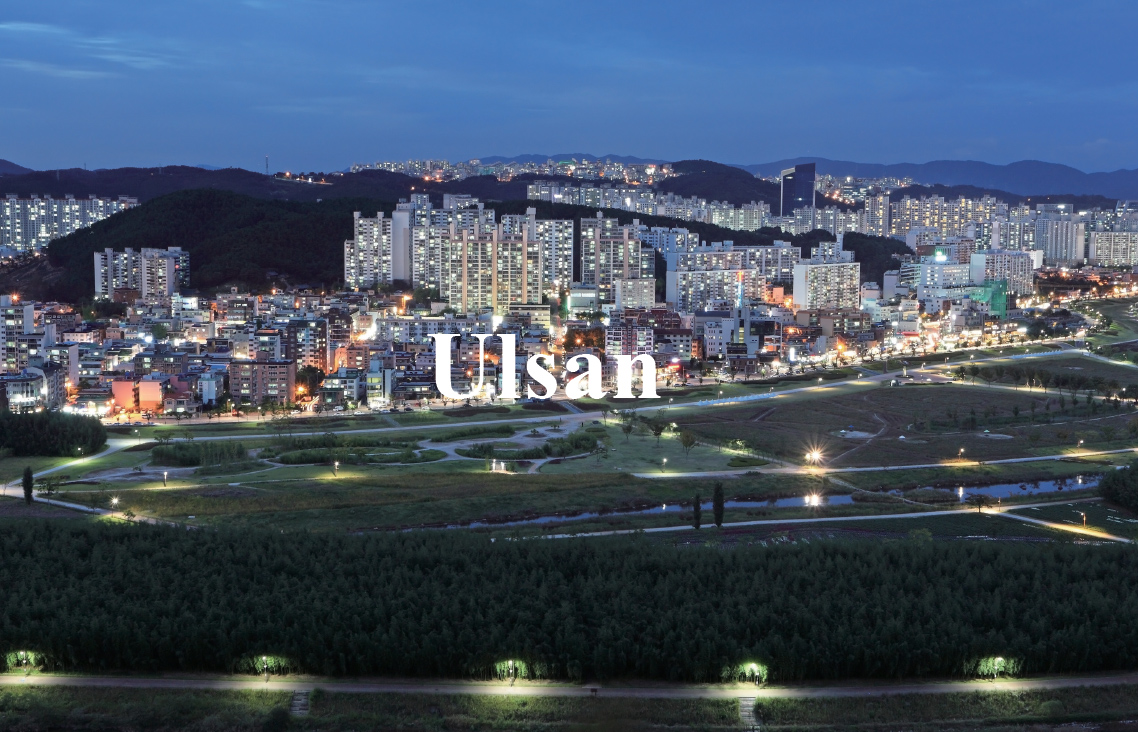
Pittsburgh, downfall of steel making city to successful future-oriented city
Rust Belt is an expression used in reference to past industrial regions of Mid-West and North-East (Pennsylvania, Michigan, Ohio Illinois) of the U.S. It includes Detroit the center of automobile industry and Pittsburgh the center of steel making. In 1950s, they were not only the center of manufacturing business in the U.S but also worldwide. They created 50% of production and employment in the U.S. Especially, Pittsburgh was the representative city of steel making industry that held 60% of all steel production based on the location advantage and the rich reserves of coal. However, as it is possible to speculate from the word “Rust”, the Rust Belt including Pittsburgh fell behind the competition with post industrial countries such as Korea, Japan, Taiwan, and China due to the declined competitiveness of the manufacturing technology and dwindling productivity since 1970s. Pittsburgh’s manufacturing industry including the steel making industry shrunk significantly. From the 1970s to 1980s, 75% of steel making plants of Pittsburgh were closed down, and more than 350 thousand workers lost their jobs. Eventually, the representative city of Rust Belt, Detroit could not overcome such crisis and declined gradually starting in the 1970s and went bankrupt in 2013. On the other hand, Pittsburgh overcame the past crisis and has developed into a future-oriented city that leads the 4th Industrial Revolution based on IT industry and bio-industry. In 2009, Pittsburgh hosted the G20 Leaders’ Summit. The President of U.S Barak Obama said in the closing address, “Pittsburgh is a successful future-oriented city that leads the 21st century new industry rather than a city of declined steel making industry.” It showed a symbolic event to present such change. Currently, there exist more than 16 hundred IT and bio related high-notch technology enterprises in Pittsburgh. Pittsburgh has reinvented itself as a future-oriented city while being selected as one of 10 successful cases of attracting venture investment and 5 favorable cities to live.
Such successful change of Pittsburgh was achieved on the basis of educational institutes within the area around the prestigious Carnegie Mellon University in the fields of computer science and robotics and the world-famous University of Pittsburgh in the fields of medical and bio. These universities established high-tech centers in cooperation with the State Government and venture companies in the area and have led the technical development of IT and bio industries. They have also put great efforts into supporting startups through venture capital. Through such effort toward the industrialization of R&D, there are now branch offices and research centers of Microsoft, Apple, Google, Intel, and Oracle in Pittsburgh. The active industry-academy collaboration has been in progress through partnerships with Carnegie Mellon University and the University of Pittsburgh. Many engineers who are working in enterprises within the area are the graduates of Carnegie Mellon University and the University of Pittsburgh. The Universities have been helping companies to adopt cutting edge technologies through active industry-industry collaboration within the areas of Pittsburgh. They have been creating a virtuous circle through the process of hiring excellent graduates who possess the experiences of industry-academy collaboration. As a result, both schools and companies in Pittsburgh have been able to expand and IT and bio industries have grown rapidly. Pittsburgh has accomplished a successful transition to a Brain Belt from being the Rust Belt.
-
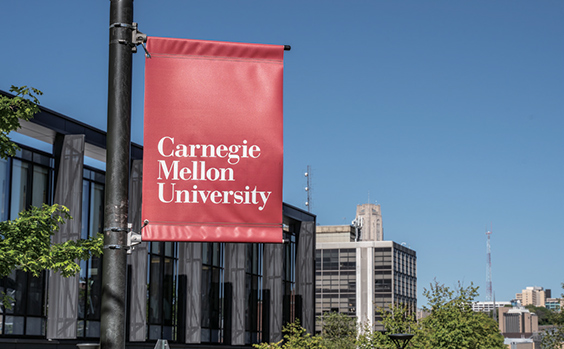 <1. Carnegie Mellon University>
<1. Carnegie Mellon University>
-
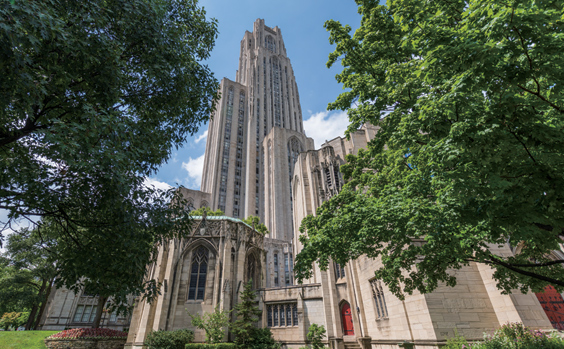 <2. University of Pittsburgh>
<2. University of Pittsburgh>
Ulsan, to be born again as the representative city of smart manufacturing based on AI from a traditional industrial city
Ulsan Metropolitan City is the largest industrial city in Korea. The three representative industries here are the automobile industry developed around Hyundai Motors, the ship building industry around Hyundai Heavy Industry, and the petrochemical industry (SK Energy, SK Lubricants, S-OIL, etc). On the basis of geographical advantage including a large-scale seaport, Ulsan was designated as a special industrial district. Since then, factories of domestic and overseas giant enterprises in relation to automobiles, heavy industry, and petrochemicals have moved to Ulsan. On account of such movement, Ulsan has been able to retain today’s appearance as the largest industrial city in Korea in terms such as the nationwide number one GRDP and the highest regional financial independence except the capital area.
However, like Pittsburgh in the 1970s, Ulsan, entering 2010s, went through recession in the ship building industry that was one of three representative industries, owing to the price competition of late comers such as China and other countries. As a result, Hyundai Heavy Industry and partnership companies suffered a heavy blow and the local economy of Ulsan also went through difficulties. Moreover, from 1962, the sharply increasing population slowed down gradually and reached its peak in 2015. But its current state shows a rather decreasing tendency.
Therefore, recently the City of Ulsan has also started a multilateral effort to evolve from the traditional industrial city into a smart industrial city like Pittsburgh. At the center of this effort, the city operates regional educational institutes and industry-academy collaboration based on AI. In order to maximize such industry-academy collaboration, the collaboration between academy and industry is necessary together with enterprises of middle standing and SMEs rather than giant enterprises. For instance, one of the 3 representative industries, the automobile industry highly depends on the manufacturing enterprises of middle standing and SMEs. As for the industry of automobile parts, giant enterprises occupy 32.6% (269 companies) among 824 primary partnership companies that do direct business with the companies that make complete automobiles. On the other hand,, enterprises of middle standing and SMEs occupy 67.4% (555 companies as of 2019). Also, the ratio of enterprises of middle standing and SMEs has been higher in the order of secondary partnership companies and tertiary partnership companies.
Therefore, the City of Ulsan shows such a characteristic that industry-academy collaboration has been actively pursued with not only giant enterprises but also regional partnership companies of middle standing and SMEs, as well as startups. In September 2020, Ulsan was selected as an Additive Manufacturing Hub, which has been a representative case that shows the result of such efforts. AM Hub is one of the core projects by the World Economic Forum (WEF) which is a global collaboration network, formed among manufacturers, research and education agencies, and government officials including enterprises of middle standing and SMEs in order to change the traditional industrial city to the smart industrial city. The AM Hub includes 8 regions of Basque in Spain, Copenhagen in Denmark, Istanbul in Turkey, Lombardy in Italy, Michigan and New England in the U.S, Queens Land in Australia, and São Paulo in Brazil. The City of Ulsan became the 9th member and registered as the first city in Asia to join the AM Hub. Ulsan has been not only introducing technologies and experiences of other regions of AM Hub but also sharing with them the process to overcome the crisis and transform to a smart industrial city successfully through industry-academy collaboration. Especially, the 4th Industry-Academy Innovation Research of UNIST has been scheduled to hold the Global AM Hub Forum at Ulsan in November 2021. It is expected that the Forum will help to strengthen the collaboration with regions of the AM Hub and share knowledge together with the WEF.
-
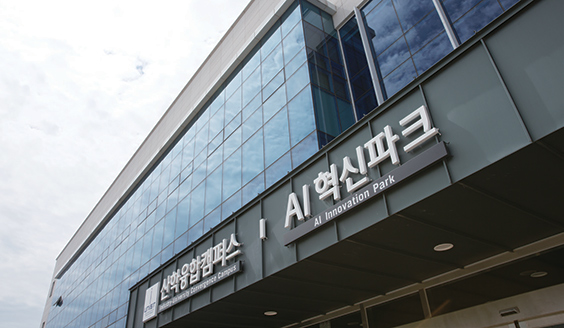 <3. AI Innovation Park>
<3. AI Innovation Park>
-
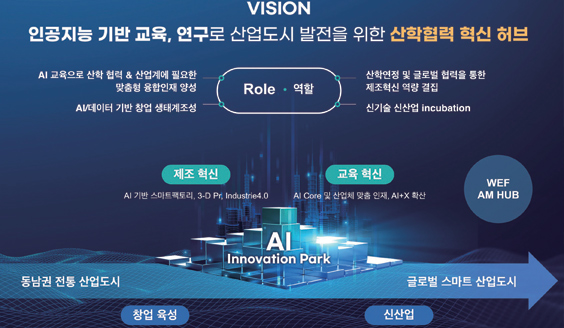 <4. AI Innovation Park VISION>
<4. AI Innovation Park VISION>
Active investment and exchange are necessary for the mutual growth of local based colleges and local society.
Like Carnegie Mellon University and University of Pittsburgh, UNIST is at the center of the industry-academy collaboration in the City of Ulsan. Especially, the AI Innovation Park of UNIST started in January 2021 in the east-southern district including Ulsan through support from the Ministry of Science and ICT and Ulsan Metropolitan City with a goal to create a manufacturing innovation ecosystem based on data, network, and AI (DNA). The core projects of the AI Innovation Park are (1) the fostering of manpower through expanding education for employees working in industries, (2) strengthening research through industry-academy collaboration on AI+X (Ex: AI+ Automobile, AI+ Ship Building, AI+ Petrochemicals) and (3) reinforcing the support for venture businesses through fostering AI startups. These initiatives will proceed with the prerequisite collaboration with enterprises. Especially, the representative project of the AI Innovation Park is the AI Novatus Academia that is led by the 4th Industry Innovation Research of UNIST. The AI Novatus Academia proceeds with a two-month long free course on AI technology targeting employees in industries. It continues with a project to carry out Project-Based Learning (PBL) for 3 months to resolve the problems in the manufacturing field through the AI technology that they have learned for 2 months.
Based on precedent research projects, such projects will be developed into a industry-academy collaboration research in relation to AI+X by supporting the annual budget of 100 million won (Including 20% share by enterprises) for each project that is considered as a large technical and project-wise influence on actual industrial fields. The AI Novatus Academia began the first term in February 2021. The second term of PBL that started in July has been in progress. Both first term and second term were supported by many employees working with the manufacturers of middle standing and SMES in the east-south district regions including Ulsan. It shows a high interest among industries of middle standing and SMEs in the innovation of manufacturing through AI. In addition, the AI Innovation Park gave AI-related startups an opportunity to move in to the UNIST’s Industry-Academy Convergence Campus. Moved-in Enterprises have received the opportunity to collaborate with the team of professors in UNIST and the benefits of using computer infra such as GPU Server.
As Pittsburgh changed from a city of the Rust Belt to a successful future-oriented city through industry-academy collaboration around Carnegie Mellon University and University of Pittsburgh, the City of Ulsan expects to develop the smart manufacturing industry significantly through various industry-academy collaborations based on AI between UNIST and local manufacturers. Once this is achieved, Ulsan will be born again to the representative city of smart manufacturing in the world beyond the Republic of Korea.

